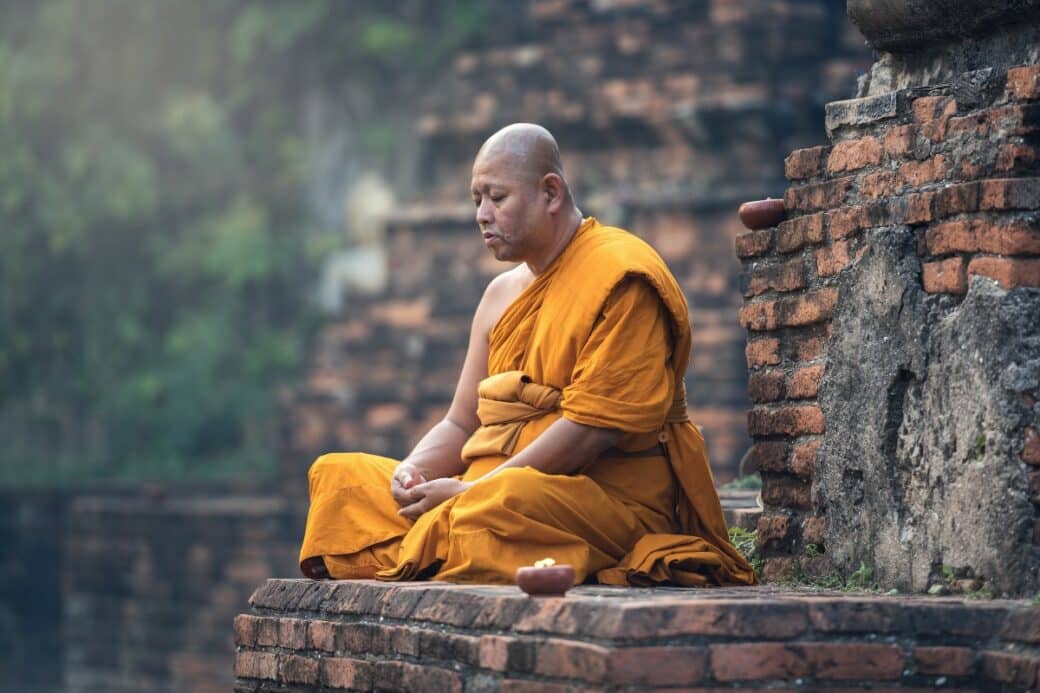Imagine a peaceful oasis, where your thoughts are calm, and your mind is at ease. Have you ever wondered where the practice of meditation originated? In this article, we will explore the origins of meditation and delve into its fascinating history. From ancient civilizations to modern times, discover how this timeless practice has evolved and found its place in our busy world. So, sit back, relax, and embark on a journey through time to uncover the captivating origins of meditation.

Understanding the Concept of Meditation
Defining meditation
Meditation is a practice that has been around for thousands of years and has been embraced by cultures and religions worldwide. At its core, meditation is an intentional act of focusing one’s attention and achieving a heightened state of consciousness. It involves cultivating a sense of calm, tranquility, and inner peace through various techniques and practices.
What does meditation entail?
Meditation encompasses a wide range of practices and techniques, including mindfulness, concentration, visualization, and breathing exercises. While the specific methods may vary, the fundamental goal remains the same: to quiet the mind and promote self-awareness. Some forms of meditation involve sitting in a cross-legged position, while others can be practiced while lying down, walking, or even engaging in daily activities.
Common misconceptions about meditation
Several common misconceptions about meditation can hinder people from fully embracing its benefits. One misconception is that meditation requires completely emptying the mind of all thoughts. In reality, meditation is about observing thoughts without judgment and gently returning focus to the chosen point of concentration.
Another misconception is that meditation is solely a spiritual or religious practice. While meditation is indeed deeply rooted in many religious traditions, it has also become widely practiced by individuals seeking stress reduction, mental clarity, and overall well-being, regardless of their spiritual or religious beliefs.
The Earliest Evidence of Meditation
Meditation in pre-historic times
The origins of meditation can be traced back to prehistoric times, predating recorded history. Cave paintings and archaeological discoveries have provided evidence of early humans engaging in activities that resemble meditation. These practices likely emerged as a way to connect with nature, induce altered states of consciousness, and tap into a deeper understanding of the world and oneself.
Archaeological findings and interpretations
Archaeological findings from ancient civilizations such as the Indus Valley, Mesopotamia, and Egypt further highlight the prevalence of meditation-like practices in early human societies. Artifacts such as statues depicting serene figures in meditative postures and inscriptions referring to mental cultivation suggest that meditation played a significant role in these cultures.
Interpreting these archaeological findings requires a nuanced understanding of the cultural contexts and belief systems of these ancient civilizations. While the exact techniques and purposes of their meditation practices may remain uncertain, it is clear that meditation has been ingrained in human civilization for millennia.
Contribution of ancient civilizations
Several ancient civilizations made significant contributions to the development and spread of meditation practices. In India, meditation became deeply rooted in Hindu traditions, evolving from early Vedic rituals to more structured practices outlined in the Upanishads and later codified in the Yoga Sutras of Patanjali.
In Buddhist traditions, meditation played a pivotal role in the enlightenment of Siddhartha Gautama, leading to the establishment of various meditation techniques and schools of thought. In China, Taoism and Confucianism integrated meditation into their philosophies, emphasizing harmony, inner reflection, and self-cultivation.
Meditation in Hindu Traditions
Role of meditation in Vedas
The Vedas, ancient sacred texts of Hinduism, contain references to meditation as a means of spiritual awakening and communion with the divine. Meditation was seen as a pathway to transcendence and acquiring knowledge of the self and the universe. The Rigveda, the oldest of the Vedic texts, mentions the practice of meditation in hymns that praise the power of concentration and mental clarity.
Evolution of meditation practices in Upanishads
The Upanishads, a collection of philosophical treatises within the Vedic tradition, delved deeper into the exploration of the self through meditation. Concepts such as Atman (the eternal self) and Brahman (the ultimate reality) were explored through introspective practices aimed at realizing one’s true nature. The Upanishads laid the foundation for more structured meditation practices and philosophies in Hinduism.
Introduction of meditation in Yoga Sutras
The Yoga Sutras of Patanjali, compiled around the 2nd century BCE, provided a comprehensive guide to meditation within the broader context of yoga. Patanjali outlined the eight limbs of yoga, known as Ashtanga, which included meditation as a crucial component. The Yoga Sutras emphasized the importance of concentration, mindfulness, and self-discipline in achieving inner stillness and self-realization.
Meditation in Buddhist Traditions

The role of meditation in Buddha’s enlightenment
Buddhism, founded by Siddhartha Gautama in the 5th century BCE, places a strong emphasis on meditation as a means to attain enlightenment. The historic moment when Siddhartha Gautama meditated under the Bodhi tree and reached enlightenment is one of the most significant events in Buddhist history. This pivotal event highlights the transformative power of meditation in realizing the true nature of reality and breaking free from suffering.
Different types of Buddhist meditation techniques
Buddhist meditation encompasses various techniques that serve different purposes. Samatha meditation, also known as calm-abiding meditation, focuses on developing equanimity and concentration through sustained attention on a chosen object. Vipassana meditation, or insight meditation, involves cultivating awareness and understanding of the nature of the mind and phenomena.
Other forms of Buddhist meditation include Metta meditation (loving-kindness), walking meditation, and body scan meditation. These practices aim to cultivate qualities such as compassion, mindfulness, and wisdom.
Spread of Buddhist meditation
As Buddhism spread throughout Asia, so did the practice of meditation. Different schools and sects within Buddhism developed their own unique approaches to meditation, incorporating local cultural influences and adapting to the needs of their respective communities. This led to the proliferation of diverse meditation techniques and traditions across countries like China, Japan, Thailand, and Tibet.
Meditation in Taoist and Confucian Traditions
Meditation in ancient Chinese philosophy
In ancient China, both Taoism and Confucianism incorporated meditation into their philosophical teachings. Taoism, founded by Lao Tzu, emphasizes living in harmony with the Tao, the underlying principle of the universe. Meditation was seen as a way to cultivate Wu Wei, effortless action, by quieting the mind, aligning with nature, and embracing spontaneity.
Confucianism, on the other hand, focused on ethical and societal principles but also recognized the importance of personal cultivation. Meditation in Confucianism aimed at fostering inner reflection, moral development, and the attainment of wisdom to benefit society as a whole.
Influence of Taoism and Confucianism on meditation
Taoist and Confucian meditation practices influenced each other through centuries of interaction, giving rise to a rich tapestry of techniques. Combining the mindfulness and deep breathing of Taoist meditation with the moral contemplation and self-reflection of Confucian meditation, practitioners sought to harmonize the internal and external aspects of their lives.
This synthesis of Taoist and Confucian thought played a significant role in shaping the development and spread of meditation in East Asia, serving as a foundation for practices in countries such as China, Korea, and Japan.
Breathing techniques and mindfulness in Taoist meditation
Taoist meditation heavily emphasizes breathing techniques and mindfulness. Practitioners engage in deep abdominal breathing, often called “diaphragmatic breathing,” to cultivate relaxation, vitality, and a sense of connectedness with the life force energy known as Qi. They also employ visualization, inner alchemy, and energy circulation practices to refine their physical and spiritual energies.
Mindfulness is another central element of Taoist meditation, involving the awareness and observation of present moment experiences. By cultivating non-judgmental awareness and discernment, Taoist meditators aim to gain insight into the impermanence and interconnectedness of all things.
Meditation in Other Eastern Religions
Meditation practices in Jainism
Jainism, one of the oldest religions in the world, places great emphasis on non-violence, truth, and spiritual evolution. Meditation in Jainism serves as a means to purify the soul, attain liberation from the cycle of birth and death, and cultivate qualities such as compassion and detachment. Practitioners engage in various forms of meditation to develop self-discipline, mental clarity, and self-realization.
Sikh meditation techniques
Sikhism, a monotheistic faith founded in the 15th century in the Indian subcontinent, incorporates meditation as an integral part of its spiritual practices. Sikhs utilize meditation techniques such as Simran (remembrance), Naam Japna (repeating the divine name), and Shabad Guru (meditating on holy scriptures) to connect with the divine and achieve spiritual awakening. Sikh meditation aims to cultivate a sense of oneness, humility, and selfless service.
Shinto and the introduction of meditation in Japan
Shinto, the indigenous religion of Japan, has a rich tradition of meditation practices intertwined with nature worship and animistic beliefs. Shinto rituals and ceremonies often involve meditation-like practices, such as sitting or standing in quiet contemplation before sacred sites or natural landmarks. These practices aim to foster a sense of reverence, gratitude, and interconnectedness with the divine forces present in the natural world.
The Arrival of Meditation in the Western World
Early introductions of meditation
Meditation began to gain traction in the Western world during the late 19th and early 20th centuries. The Theosophical Society, founded by Helena Blavatsky and others, introduced the concept of Eastern philosophies and practices to Western thinkers, including meditation.
Swami Vivekananda, an influential Indian spiritual teacher, brought meditation to the forefront of Western consciousness through his lectures and teachings at the 1893 World’s Parliament of Religions in Chicago. His emphasis on meditation as a means of realizing one’s true nature and experiencing a direct connection with the divine garnered significant interest and sparked further exploration of Eastern practices in the West.
The influence of Transcendental Meditation
Transcendental Meditation (TM), brought to the West by Maharishi Mahesh Yogi in the 1950s, played a crucial role in popularizing meditation among Western audiences. TM offered a simplified technique that involved the repetition of a personal mantra, making meditation more accessible and appealing to a broader range of individuals.
The Beatles’ association with Maharishi Mahesh Yogi and their public endorsement of TM further propelled meditation into the mainstream. The influence of TM and the celebrity endorsements it garnered increased public awareness of meditation and sparked a broader interest in Eastern spiritual practices.
The role of the counter-culture movement in promoting meditation
During the 1960s and 1970s, the counter-culture movement in the West embraced meditation as a means of personal liberation, spiritual exploration, and societal transformation. Rejecting traditional norms and seeking alternative ways of living, many individuals turned to meditation as a vehicle for self-discovery and social change.
This cultural awakening led to the widespread integration of meditation practices into various cultural spheres, including music, art, literature, and psychology. The works of influential figures such as Timothy Leary, Alan Watts, and Ram Dass further popularized meditation and its potential to expand consciousness and promote well-being.
Scientific Study of Meditation
Initial research efforts
In the late 20th century, scientific interest in meditation began to grow, leading to an increase in research exploring its physiological, psychological, and neurological effects. Early studies focused on practitioners of Eastern traditions, such as Tibetan monks and Zen meditators, and examined the subjective experiences and physiological changes associated with meditation.
Researchers began to measure brain waves, heart rate variability, and hormone levels to gain insights into the physiological and psychological impacts of meditation. These initial studies laid the groundwork for further scientific exploration and the emergence of a field now known as contemplative neuroscience.
Neurological benefits of meditation
Modern neuroscience has shed light on the profound benefits of meditation on the brain and overall well-being. Neuroimaging studies have revealed that regular meditation practice can lead to structural and functional changes in the brain, such as increased gray matter density and enhanced connectivity between different brain regions.
Meditation has been shown to reduce activity in the default mode network, the brain network associated with mind-wandering and self-referential thinking, while increasing activity in regions responsible for attention, emotion regulation, and empathy. These changes correlate with improvements in cognitive functions, emotional well-being, and stress reduction.
Impact of consistent meditation on stress and mental health
Meditation has become increasingly recognized as a powerful tool for managing stress and promoting mental health. Numerous studies have shown that regular meditation practice can reduce levels of stress hormones, decrease anxiety and depression symptoms, and improve overall psychological well-being.
Mindfulness-based interventions, which incorporate mindfulness meditation, have been particularly effective in treating various mental health conditions, including depression, anxiety disorders, and post-traumatic stress disorder (PTSD). Many therapeutic modalities now integrate meditation as an evidence-based approach to support mental health and well-being.
Changing Perception of Meditation in the Modern Era
Meditation as a form of therapy
In recent years, meditation has gained recognition as a valuable therapeutic tool in the fields of psychology, psychiatry, and counseling. Mindfulness-based interventions, such as Mindfulness-Based Stress Reduction (MBSR) and Mindfulness-Based Cognitive Therapy (MBCT), have been widely adopted in clinical settings to complement traditional treatments.
These meditation-based therapies provide individuals with practical techniques to manage stress, alleviate symptoms of anxiety and depression, and enhance overall resilience. By cultivating non-judgmental awareness and acceptance, meditation as a form of therapy empowers individuals to become active participants in their own healing process.
Emergence of secular meditation practices
While meditation has its roots in various religious and spiritual traditions, secular forms of meditation have gained considerable popularity in the modern era. Non-religious meditation practices, stripped of any religious or philosophical beliefs, have emerged to cater to individuals seeking the benefits of meditation without any spiritual or ideological baggage.
Mindfulness meditation, in particular, has received significant attention and has been integrated into educational institutions, corporations, and healthcare settings. Mindfulness programs in schools aim to enhance focus, emotional regulation, and well-being among students, while workplace mindfulness initiatives seek to reduce stress, improve productivity, and foster a healthier work environment.
The role of technology in making meditation accessible
Advancements in technology have brought meditation practices to the fingertips of virtually anyone with a smartphone or internet connection. Meditation apps, such as Headspace, Calm, and Insight Timer, offer guided meditations, breathing exercises, and personalized programs that make meditation accessible to a broader audience.
Virtual reality (VR) and augmented reality (AR) technologies have also entered the meditation scene, providing immersive experiences that create a sense of calm and tranquility. These technological innovations have democratized meditation, eliminating barriers of time, location, and resources, and allowing individuals to customize their meditation journey according to their needs and preferences.
The Future of Meditation
Trends shaping the future of meditation
As meditation continues to gain popularity and acceptance, several trends are shaping its future. The integration of meditation into healthcare systems is becoming more mainstream, with meditation programs being offered in hospitals, clinics, and mental health centers as a non-pharmacological approach to support wellness and recovery.
The field of workplace wellness is also embracing meditation as a means to reduce stress, enhance productivity, and foster employee well-being. Companies are incorporating meditation into their wellness programs, providing employees with dedicated spaces and time for meditation practice.
Furthermore, the fusion of technology and meditation is expected to continue evolving. Wearable meditation devices and biosensors that track physiological responses during meditation may enhance self-awareness and provide real-time feedback, further enhancing the meditation experience.
Potential challenges and controversies
While the future of meditation appears promising, it is not without challenges and controversies. Ensuring the integrity and authenticity of meditation practices in a commercialized and rapidly expanding market can be a challenge. The risk of diluting the essence of meditation or oversimplifying its profound teachings may arise as it becomes mass-marketed and commodified.
Cultural appropriation is another concern, as Western societies continue to adopt and adapt meditation practices from Eastern traditions. It is essential to respect the roots, cultural contexts, and diversity of meditation practices, acknowledging and honoring their origins while adapting them to modern contexts.
The role of meditation in an increasingly digital society
In an increasingly digital and interconnected society, the role of meditation is poised to address the growing need for balance, mindful presence, and digital well-being. As individuals become more immersed in technology, meditation offers a counterbalance by providing an opportunity to disconnect, cultivate self-awareness, and reconnect with the present moment.
Meditation can serve as a powerful tool for managing digital overload, fostering healthy relationships with technology, and reimagining how individuals engage with the digital world. By incorporating mindfulness and meditation practices into digital experiences, technology can support individuals in maintaining a sense of presence, focus, and well-being.
In conclusion, the practice of meditation has a rich and diverse history that spans across cultures, religions, and centuries. From its ancient roots to its modern-day applications, meditation continues to evolve, adapt, and offer transformative benefits to individuals and communities worldwide. As we embrace the future, the practice of meditation holds the potential to cultivate greater self-awareness, compassion, and connectedness in an ever-changing world.




